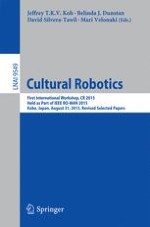2016 | OriginalPaper | Chapter
The Performance of Creative Machines
Authors : Petra Gemeinboeck, Rob Saunders
Published in: Cultural Robotics
Publisher: Springer International Publishing
Activate our intelligent search to find suitable subject content or patents.
Select sections of text to find matching patents with Artificial Intelligence. powered by
Select sections of text to find additional relevant content using AI-assisted search. powered by
